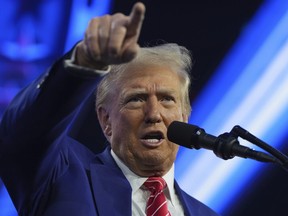Article content
Canada unveiled a new defence strategy that focuses on strengthening its military capabilities in the Arctic region, but its spending by the end of the decade will still be short of the two per cent target set by the North Atlantic Treaty Organization (NATO).
The strategy adds an extra $8.1 billion over the next five years, allowing Prime Minister Justin Trudeau’s government to spend 1.76 per cent of gross domestic product on defence by 2030. The government describes the plan as a “major step” toward reaching the two per cent threshold and also projects Canada will exceed NATO’s target of 20 per cent for equipment spending as a proportion of defence funding.
Article content
Canada had previously been on track to spend 1.59 per cent of gross domestic product on defence by 2027, according to a parliamentary budget officer report in 2022.
Overall, Canada’s military spending will rise from about $30 billion currently to $49.5 billion in the fiscal year ending in 2030. Accounting for defence-related spending in other departments, Canada’s total defence spending will be just under $58 billion by 2030, government officials said.
Canada has been pressured by its allies to spend more on defence, particularly as NATO struggles to keep Ukraine supplied in its fight against Russia’s invasion.
David Cohen, the United States’s ambassador to Canada, released a statement that praised the new spending, calling it “a substantial down payment toward Canada’s pledge to meet its NATO commitment.”
Cohen said that getting to 1.76 per cent of GDP by 2030 “is real progress, and we are also encouraged by the assurances we have received that there will be additional investments.”
The new strategy also puts heavy emphasis on Canada’s Far North.
“The most urgent and important task we face is asserting Canada’s sovereignty in the Arctic and northern regions, where the changing physical and geopolitical landscapes have created new threats and vulnerabilities to Canada and Canadians,” says the government in the strategy document, called Our North, Strong and Free.
Article content
The government says in the strategy that autocracies are increasingly “challenging the international order,” and specifically mentions “Russia’s flagrant violation of international law and China’s attempts to reshape the international order to achieve its political goals.”
It says Canada will establish a greater presence and reach in the Arctic “through a network of northern operational support hubs, a fleet of airborne early warning aircraft, deployable sensors on our coasts and underwater, a satellite ground station in the High Arctic, enhanced foreign intelligence capabilities and new tactical helicopters.”
Canada is committed to defending North America from aerospace threats in partnership with the U.S., the government says, pledging to build on investments already made under its North American Aerospace Defence Command (NORAD) modernization plan and further explore Canada’s integrated air and missile capabilities.
Recommended from Editorial
-
Canada to resume drone exports to Turkey after defence deal
-

Shipbuilding: The new battleground in the U.S.-China trade war
-

Aerospace firms tout upside of a Boeing military deal
It also says “new and disruptive technologies are rapidly redefining conflict and what it takes to be safe and secure.”
Climate change is also disproportionately affecting the Arctic, the strategy says, noting that it makes the area increasingly accessible, which creates new security challenges.
Bloomberg.com
Share this article in your social network
Canada’s defence policy update still misses NATO target
2024-04-08 15:59:59







